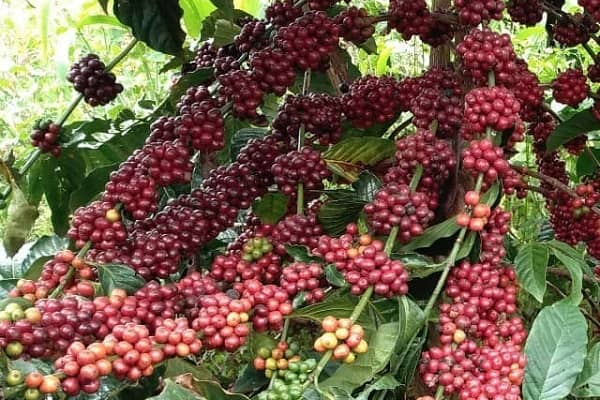Did you know that coffee plants also can be grown indoors. Coffea is the scientific name for the coffee plant. Coffee plants naturally add beauty to your home as a houseplant.
Coffee Plant- Indoors
Coffea plants are beautiful in themselves, this plant is a pretty bush with shiny green leaves. During the early summer, it bloomed with scented white flowers. Several species are cultivated for the coffee beans but for wide commercial coffee production, Coffea arabica and Coffea canephora are grown.
Where to Grow Coffee Plants?? Indoors
If you want to grow your coffee plants at your home as indoor plants then here are the three places where you can grow happy and healthy coffee plants.
1. Pot
Usually, people grow their plants in the pot. During the summer you can place your coffee beans poy outside. But it should not get the direct sun, so for that you should find and place it in a shady pot. In the winter, you can place it in the window facing east to west where the sun shines for a shorter period. Because of the humidity, it is important to keep in mind that you need to spray the leaves regularly.
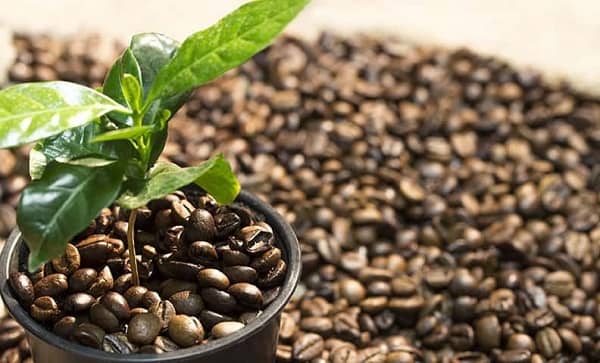
2. Hydroponic Coffee Growing In a Jar
For this method, your plants will grow in a tight-fitting glass jar. You need to place Lightweight expanded clay at the bottom for drainage and then plant the coffee plant seed. For a smooth process, you need to keep everything well moistened and in a bright place but avoid direct sunlight.
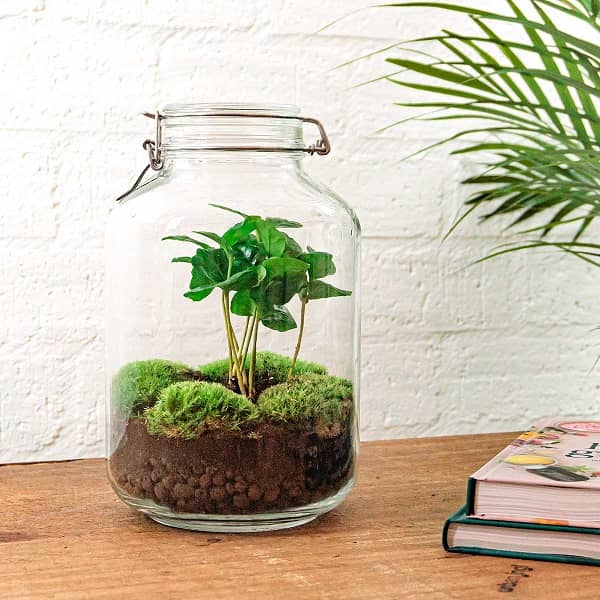
3. Kokedama
Another process for growing a healthy coffee plant is Kokedama where you need a small coffee plant tree that is already grown. For this process, you start by dipping the root ball in the freshwater and covering it with a peat-clay mixture. Wrap the root ball with a dry sheet of most and tie everything very nicely with a string. For faster and better growth you need to hang up the kokedama by the string and simply spray the moss ball with water for its good moisturizer.
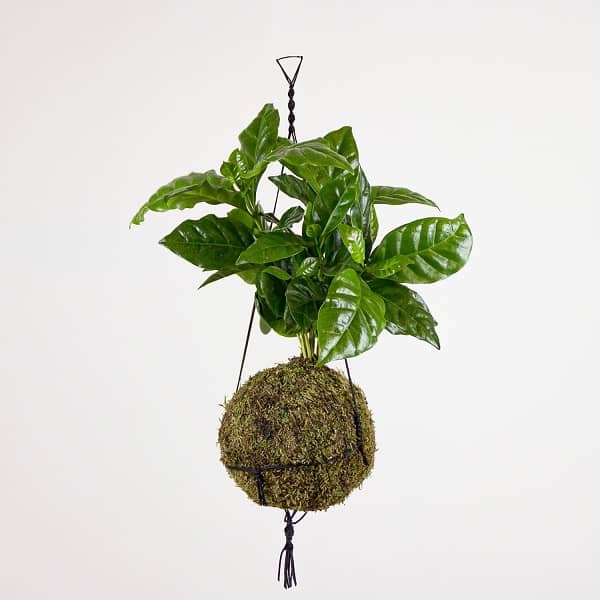
How to grow coffee plants?
Coffee plants are easier and fun to grow, Coffea arabica needs a warm spot of direct sunlight because it is native to tropical areas of Africa and Asia.
In each two to three years you need to repot your coffee plants. The best time to repot the coffee plant is in the spring. Make sure that while re-poting you need another container size up using loam-based, peat-free compost..
Sunlight
Coffee plants need bright to grow perfectly but they usually take indirect sunlight. Avoiding the full sun is the best option for it, if it gets full sunlight then its leaves will get scorched and turn brown.
Temperature
The plant should be kept at around 16-24ºC and at a slightly lower temperature during the winter. Similarly, a bathroom would be an ideal idea for the coffee plant as they like bright light and humidity
On the other hand, it can also be placed near the window of your room but not directly in the window itself.
They can do well in freezing temperatures and stay stuck in temperatures below 65 degrees F. (18 C)
Soil
While growing the coffee plant the soil is needed to stay moist but not soaking wet. A thing to keep in mind is that both the soil and pots your coffee plants are growing in with good drainage.
Watering
It’s important to water the coffee plants regularly but do not overwater. After half of the soil has dried out you can water the plant thoroughly and be sure to use a pot with drainage holes to prevent water in the soil. Avoid watering on the leaves because it can cause them to develop brown spots or fungal infections.
Humidity
Also, the humidity of the plant needs to stay high, a coffee plant needs less water in the winter than in the summer. A perfect coffee plant includes light fertilizing with balanced fertilization once or every two to three months in the spring and summer only.
Healthy and happy coffee plants can grow up to 6 feet 2 m tall. So, make sure that your coffee plant has enough space to grow.
History of Coffee? How it is Generated
For the very first time, coffee was generated in Ethiopia. However, there is a Fascinating history of coffee, an Ethiopian goat herder named Kaldi, noticed that his goats acted very energetic after eating berries from a certain tree. After seeing that he tried those berries and felt so energized.
Meanwhile, he shared his discovery with the local monks, who began to use the berries to make a drink that helped them stay awake during long hours of prayers.
According to the collected evidence, coffee beans were used in Ethiopia around 850 AD. In the past days, the coffee beans were chewed off the ground into a paste and mixed with fat. Lately in the 15th century coffee beans have been roasted and brewed into a drink.
Propagation of coffee plants
You can easily buy the coffee plant for the market but you can also grow it from seed. For the seeding process, you need to soak seeds overnight and spread on onto the surface of the moist compost. Cover it with a thin layer of compost and keep it at a degree of 27-29ºC. Usually, it takes 6 to 8 weeks for seeds to germinate.
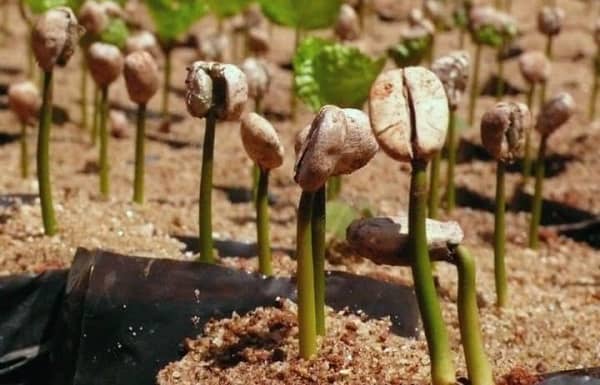
How long does it take to produce beans from coffee plants?
Coffee plants usually take around three to five years to produce for their first harvest of coffee berries or beans. However, the growth of beans depends upon several factors. But after the coffee plant blooms, it takes nine months for the berries to rip.
It’s good to eat raw coffee beans?
It’s not safe to take raw coffee beans. Raw coffee beans have high caffeine and are difficult to digest. Here are the symptoms that happen if we take raw coffee beans:
- Vomiting, diarrhea, and abdominal pain.
- Hyperactivity
- Heart palpitations and arrhythmia
- Increased panting and breathing rate
- Increased urge to urinate
- Trembling, shivering, or convulsions.
Short Note:
Besides coffee beans all the parts of the coffee plants are toxic to humans and animals so don’t consume it
Pests and diseases
To grow a healthy plant you must keep an eye on common pests such as aphids, spider mites, and mealybugs. If you notice any of these signs in your coffee plants then insecticidal soap or neem oil.
How to pollinate the coffee plants?
Pollination can be done easily on the coffee plants, if you notice that your coffee plants are blooming then you need to hand-pollinate it for fruit production. Softly transfer pollen from one flower to another using a small brush or cotton.
How can pruning be done?
Regularly pruning can make your coffee plant compact shape and encourage new growth. Always remember to remove any dead damaged or leggy branches to promote the healthy growth of the coffee plants.
Over a long period of five to ten years, coffee plants grow to 4-8 m. When you grow them indoors in a pot, they can be cut back to keep them to a desirable size. But always try to cut them in summer or spring.
FAQs
Q. Are Coffee Leaves Toxic?
Aside from coffee beans all the parts of coffee plants are toxic and cannot be digested because of the high caffeine presence in them.
Q. How Often Should We Water Coffee Plants?
Water the coffee plants regularly to keep the soil moist but avoid overwatering.
Q. How Long does it Take to Grow Berries from the Indoor Coffee Plants?
Indoor coffee plant takes 3-5 years to bloom for the first time. Once it starts to flower it takes 6-9 months to develop into coffee berries.
Also, read more about How to Grow and Care for Schefflera (Umbrella Plant)
